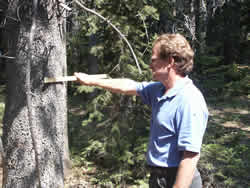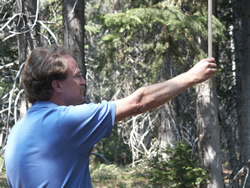Measuring Tree Volume with a Biltmore Stick
by Justin Black
A Biltmore stick, dated to the early 19th century, is one method used for measuring tree diameter and height (total or merchantable). From there, the total board feet of the tree can be established, along with tonnage and cubic feet.

Using your Biltmore stick to measure tree diameter
- Hold the stick at breast height (4.5 feet from the ground), 25" from your eye, with the back of the stick against the tree you are measuring.
- Hold the stick at a right angle to the axis of the tree and keep your eyes level with the stick.
- Adjust the stick so that the left or zero is in line of sight with the left side of the tree.
- Without moving your head, shift the line of sight to the right hand side of the trunk.
- Read the diameter on the stick nearest the point at which the line of sight crosses it.


Using your Biltmore stick to measure tree height
- Total tree height is measured from the ground to the top of the tree. Merchantable tree height is measured from the stump height to the point at which the tree is no longer usable.
- Stand 100 feet from the tree you are going to measure. If the ground is not level, stand on a spot which has about the same elevation as the base of the tree.
- Hold the stick vertical, 25" from your eye, with the “Height of Tree” side facing toward you.
- Align the base of the stick at the ground (or at your estimated stump height for merchantable height).
- Without moving your head, shift your line of sight so you can read the height at the point where your line of sight and the top of the tree intersect (or merchantable height).
- This can also be done opposite: Zero the stick at the top of the tree and check height at the ground.
Using your Biltmore Stick to determine tree volume
- Board Feet: After determining tree diameter and height (in 16 foot lengths), use the chart on the back of the Biltmore stick to determine board feet. Using the “inches” scale along the top, find your tree diameter. Look on the table corresponding to the number of 16 foot log sections you have. The number not in parenthesis will indicate board feet. If you want to determine the volume of one cut log, use the inches scale on the back of the stick to measure the small end inside the bark. The numbers in parenthesis (below your log diameter in inches) list the board feet of one log, 8, 10, 12, 14, or 16 feet long.
- Tons: After determining board feet, use the conversion chart on the back of the stick to determine either cubic feet or tons.


